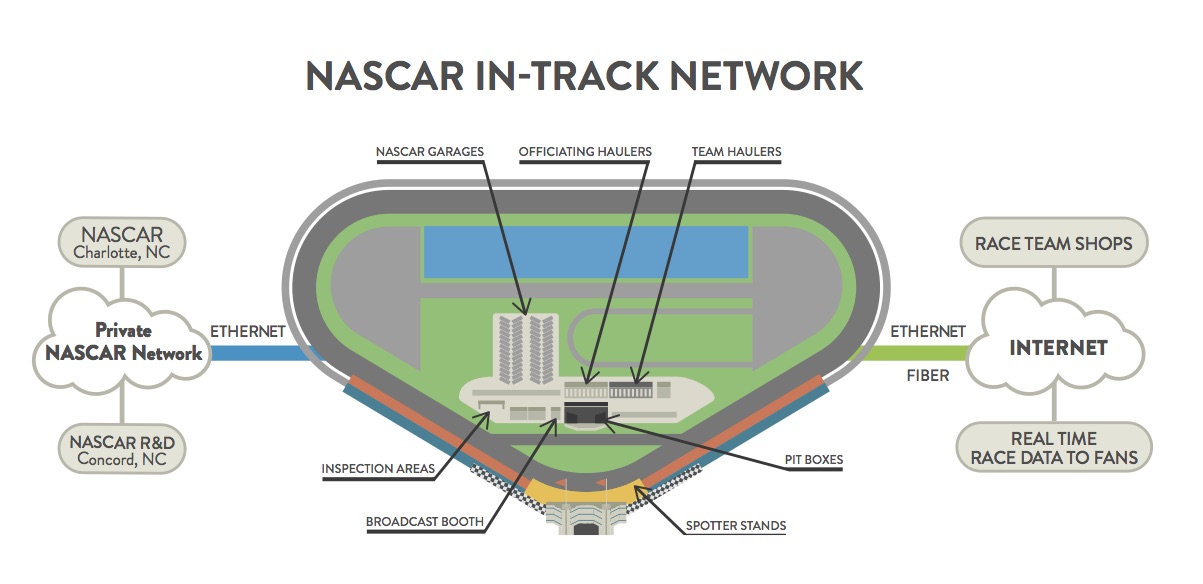Technology Transformation at the Speed of NASCAR

Leveraging technology to maximize the business opportunities it represents is no small challenge at any midsized or large enterprise, but what NASCAR (the National Association for Stock Car Auto Racing) faces in this arena is enough to make any IT specialist’s blood run cold. Imagine having to set up a high-performing network capable of hitting demanding scalability, reliability, and flexibility KPIs in a day or less, only to tear it all down again a few days later.
Now, imagine having to do that dozens of times a year – on a weekly basis throughout the racing season. That’s the challenge facing NASCAR’s Technology team, and not only are they meeting it regularly, their success is enabling improved driver safety and racing team performance along with enhanced inspection and operations efficiency for NASCAR officials.
NASCAR has a massive audience, with millions of fans in the U.S. alone following the sport. From kickoff events in February through championship rounds in November, the 2017 NASCAR schedule includes 36 Monster Energy NASCAR Cup Series, 33 XFINITY Series, and 23 Camping World Truck Series races. The Monster Energy Series is NASCAR’s most popular series, and attendance at flagship events like the Daytona 500 and the CocaCola 600 routinely surpasses 100,000 fans. Stock car racing is very much a team sport, and NASCAR itself is a massive enterprise with corresponding technology challenges. Its infrastructure has to support the needs of participating racetracks, race teams, corporate sponsors, and its own employees.
LESS-THAN-PERFECT LEGACY SOLUTIONS
Precision and optimization are critical to NASCAR, in everything from safety and inspection on the NASCAR side to performance and consistency on the race team side. Innovation and technology help drive the enterprise and are key to the sport’s evolution; connectivity, of course, is a prime enabler of those values. Providing reliable connectivity has long been a major challenge, and the IT specialists at NASCAR along with the individual race teams have leveraged various technologies to meet it. While those solutions were state-of-the-art at the time they were deployed, they all had serious shortcomings.
Early on, NASCAR used T1 lines, which meant relying on the phone company to provide hard cable connections to dozens of individual tech trucks at race venues, and sometimes relying on heated competition to secure those connections. The next phase of evolution was cellular, which worked well until cell phones and other mobile devices soared in popularity. Once the fans arrived at the racetrack, bandwidth availability got hammered. Satellite solutions were tried with varying degrees of success. Latency and weather were major obstacles. “Space is really far away, and you can’t change that, you can’t rewrite physics. We had constant problems with satellite latency, and the weather was also an issue,” said Jim Foley, chief technology officer at Joe Gibbs Racing. “A big storm would come through and we couldn’t get the satellite to lock back on, which was extremely frustrating. We have a business to run here. Being off-line costs us time and money, and that’s something no business can afford.”
THE ULTIMATE GOAL: A HIGH-PERFORMANCE, RELIABLE NETWORK
The nature of NASCAR’s underlying physical infrastructure is diverse and diffuse, with the 29 U.S. racetracks where its events take place owned by different entities. In light of the limitations encumbering its previous technology networks, NASCAR set its sights on a transformative solution that would provide it with its own highly reliable, high-performing network that could be used at all venues. Its goals for the network included:
- Improved communication among NASCAR officials, operations personnel, and race teams.
- Improved safety for drivers through enhanced inspection processes leveraging more consistent data exchange. Inspection protocols would be more accurate, take less time, and be capable of sharing and storing RFID and manufacturers’ certifications.
- Improved performance. Satellite and T1 latency issues were a major consideration in this area. NASCAR believed the ability to share data within the cloud would transform the way it does business, and they needed reliable connectivity that would allow race officials to use their officiating hauler without worrying about bandwidth issues.
- Multitasking capabilities for devices, which would be achieved by moving applications to the cloud. Besides making devices more flexible, a cloud solution would allow the NASCAR operations team and the individual racing teams to bring their own data into the garage and trackside.
- Providing Internet and local network access to race teams via private cable modem network. To achieve this objective, NASCAR now works with ARRIS to set up a private cable modem network at every race, which the race teams can use to access the Internet and communicate between the team hauler, garage area, and pit road during a race.
ETHERNET AS STRATEGIC ANCHOR
Ethernet over fiber is playing a pivotal role in the success of NASCAR’s newest technology endeavor. Ethernet’s power is improving NASCAR’s operations and enabling more productive access to critical applications. WiFi enables better race officiating, and network dependability is improving race team procedures. Network connectivity is now more reliable, more available, and less susceptible to weather conditions. Ethernet technology is cost efficient and scalable. The resulting increase in bandwidth and connectivity makes it possible for NASCAR and race teams to automate more processes and to benefit from the precision that digital technology brings to engineering.
The speed and reliability of Ethernet allows NASCAR to provide improved access to data and communication among race team members at the track. The increased bandwidth and reduced latency provide new opportunities for teams to migrate their software programs in the direction of best practices within the industry. No longer hampered by having to jury-rig work-arounds or deal with slow networks, race teams can now connect numerous devices to the racetrack network simultaneously and have them all operate at much higher speeds than was possible in the past. 
THE BENEFITS OF NETWORK RELIABILITY
It would be difficult to overstate the importance of network reliability in a sport that involves dozens of powerful race cars flying around a different racetrack every week at speeds that often exceed 200 miles per hour. That’s not the only unique challenge for NASCAR’s tech team. It also faces the daunting task of setting up and tearing down a complete network in a different location almost every week during a race season that runs from February through November. And the network has to work right out of the box, each and every time.
Network reliability is an important consideration for enterprises of all types, but it is even more important in NASCAR racing because it affects the safety of drivers, pit crew members, and officials. Everything about the cars, the tracks, and the conditions is carried over the network, so it needs to be up and running without fail.
Improved network performance also helps make NASCAR teams more competitive. The information that crew chiefs constantly feed drivers during a race is a critical factor in team performance, and it can spell the difference between the checkered flag or an also-ran finish. All the information a driver receives is communicated through the crew chief and a spotter. The value of that information hinges on how much data they can get on a computer screen – or multiple screens. Real-time analytics now provide immediate, meaningful feedback to drivers after test laps, and a crew chief sitting in a team’s “war wagon” (a central repository for each team’s tools, technology, and other race-day gear) can quarterback the entire race, making critical decisions that are instantly transmitted to the driver.
Ethernet makes all those capabilities plug-and-play for NASCAR race teams, which can connect to the Internet the moment they arrive at the track. During the race, crews have access to a live timing and scoring feed, a critical communication tool that keeps them updated on their cars’ positions and lap times – key variables in the competitive equation.
BIG IMPROVEMENTS – ON AND OFF THE TRACK
The ability of race crews to convey what’s happening both on the track and on pit road gets a significant boost from Ethernet over fiber technology. At the same time, all crew members can use their mobile devices to access critical race data and to know exactly where they need to be and when they need to get there. The network supports race team apps that remotely control certain activities in the pit box (another name for the war wagon), and access to the cloud through the robust Ethernet-based network gives teams instant access to their own data anytime and anywhere, from the garage to the track.
The network has also made pit road officiating a more transparent process by enabling real-time video from NASCAR’s new mobile pit-road inspection system to be sent directly to each team. Prior to the launch of its new inspection system, NASCAR fielded a team of 43 officials – one for each race team – on pit road during races. Their daunting charge was to monitor each car as it pitted for tire changes, fueling, wedge adjustments, and tear-offs (removal of the Mylar layers on windshields) – a frenetic process that involves half a dozen pit crew members moving in choreographed chaos and taking a mere 12 seconds. Just staying out of the way – and uninjured – was challenging enough for the NASCAR officials, not to mention making sure teams were in compliance with all NASCAR rules and regulations.
Now, NASCAR’s officials are out of harm’s way, conducting those inspections remotely, through a bank of 45 cameras that feeds video directly into the new NASCAR Officiating Trailer. The stark white interior of the jet-black trailer is lined with workstations outfitted with laptops and hi-res monitors. It doesn’t just give officials eyes on what’s happening in the pits; it provides a wealth of information to crew chiefs. So instead of spending time contesting violations, they can review video feeds and focus on helping their teams work better, smarter, and faster.
NASCAR Productions, the racing giant’s Emmy Award-winning media, marketing, and entertainment subsidiary, also benefits from the new fiber-based Ethernet network, especially the ability to quickly and easily transfer large video files between race locations and its state-of-the-art production facility in Charlotte, North Carolina. NASCAR Productions creates a wide range of content, from TV shows and commercials to feature-length films and short-form videos used on the Web and in mobile applications. Hundreds of people are involved in video production efforts on race day, all working on the fly. Ethernet provides more speed and reliability to support all the processes behind that enormous undertaking.
“The new gigabyte Ethernet has really changed the landscape for us,” said Steven Worling, managing director of NASCAR Information Technology.
WHAT’S NEXT FOR NASCAR?
The impact of NASCAR’s new Ethernet-enabled technology network on the sport of stock car racing has been enormous, especially in the areas of NASCAR operations and officiating and race team competitive capabilities and safety. Now NASCAR envisions it playing an equally transformative role in the fan experience going forward. The key will be providing more – and more meaningful – data to fans through their mobile devices. Modern racetracks are huge facilities spanning hundreds of acres. NASCAR sees data-driven solutions to provide fans with basic information on parking, seat location, ancillary events, concession stands, etc., as a logical next step. It’s also looking at ways to push relevant data about teams, cars, standings, weather, track conditions, and other race-related topics to fans in a way that will make the racetrack experience more engaging. Achieving those goals will require additional investment in technology, but NASCAR seems inclined to pursue it.
“Data is the biggest demand. The majority of today’s fans, especially the younger generations, are all heads-down with their devices,” Worling said. “They need data, so we’re already road-mapping to move to a 2-gigabyte circuit.”
Racetrack operators are adopting a similar mindset, and many are looking for ways to leverage WiFi or data systems to enhance the fan experience. As data-driven consumption of this kind of entertainment increases, mobile devices may displace television as some fans’ primary screen. NASCAR’s plans for an Ethernet-based technology future signal its recognition of just how important this development could be. Future success will depend on NASCAR’s ability to maintain connectivity across a wide range of devices and users, from internal staff and officiating crews to hosting venues to race teams and pit crews and, ultimately, to -every fan and would-be fan – whether they are sitting in the bleachers at the track, watching an event on their TV at home, or following the sport on their smartphone or tablet.
Already, the technology’s immense potential is apparent on the NASCAR and race team sides. Steve Stum, vice president of operations and technical production at NASCAR, envisions a fast-approaching time when Ethernet will make it possible to “remote the remote,” as he put it, referring to the possibility of having officials at NASCAR headquarters monitor multiple races simultaneously rather than having separate officiating teams working from trailers at the tracks. Foley is excited about the opportunity to have race car configuration specialists able to provide critical input from the race team’s garage or even their own homes, rather than having to be at the track on race day.
CONCLUSION: A “LINKED IN” FUTURE
To be sure, Ethernet-enabled technology is already providing significant benefits to the sport of stock car racing. “It’s made our lives simpler and a lot easier,” Foley said. “It’s nice to know this is an industry best practice, and we’re able to use it; it’s always right there at our fingertips. We didn’t have that kind of network for a long time, so it’s been a big step for us.”
Foley’s colleague at Joe Gibbs Racing, IT Director Charles Childers, agrees wholeheartedly. “The logistics of racing are enough to give anyone a headache, and having access to instant data online is invaluable,” he said.
Comcast is playing a part in the transformation of NASCAR technology, providing Ethernet service at a number of tracks on the NASCAR circuit. As NASCAR continues its technology evolution, Comcast looks forward to expanding its role in that development. “NASCAR is growing,” said Stum. “With Comcast Ethernet solutions, we have the ability to grow, to expand, to meet the demands of our customers, our staff, and all the teams as we all race into the future together.”
Leveraging technology to maximize the business opportunities it represents is no small challenge at any midsized or large enterprise, but what NASCAR (the National Association for Stock Car Auto Racing) faces in this arena is enough to make any IT specialist’s blood run cold.
Locked Content
Click on the button below to get access
Unlock NowOr sign in to access all content on Comcast Business Community
Learn how Comcast Business can help
keep you ready for what's next.











